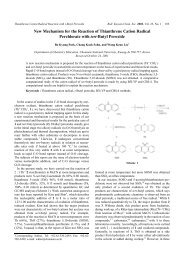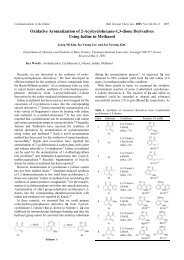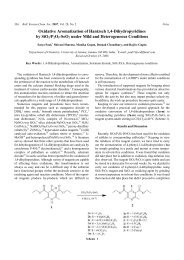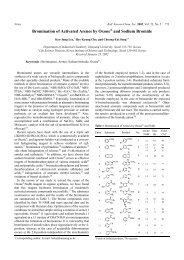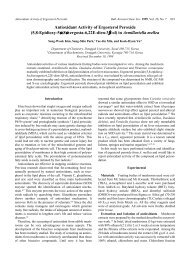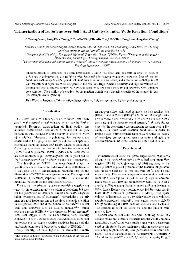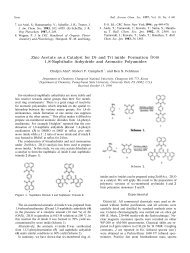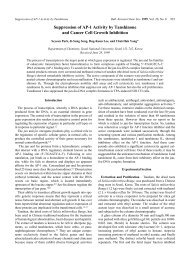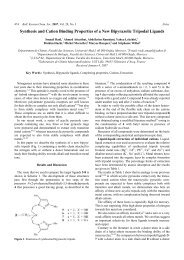Isolation of a New Chromene from the Brown Alga Sargassum ...
Isolation of a New Chromene from the Brown Alga Sargassum ...
Isolation of a New Chromene from the Brown Alga Sargassum ...
You also want an ePaper? Increase the reach of your titles
YUMPU automatically turns print PDFs into web optimized ePapers that Google loves.
Notes Bull. Korean Chem. Soc. 2007, Vol. 28, No. 10 1831<br />
<strong>Isolation</strong> <strong>of</strong> a <strong>New</strong> <strong>Chromene</strong> <strong>from</strong> <strong>the</strong> <strong>Brown</strong> <strong>Alga</strong> <strong>Sargassum</strong> thunbergii<br />
Seo, Youngwan *<br />
Eui Park, and Taek Jeong Nam Ki †<br />
<strong>of</strong> Marine Environment and Bioscience, Korea Maritime University, Busan 606-791, Korea. Division * ywseo@hhu.ac.kr<br />
E-mail:<br />
Faculty <strong>of</strong> Food Science and Biotechnology, Pukyong National University, Busan 608-737, Korea<br />
†<br />
Received June 29, 2007<br />
Key Words : <strong>Sargassum</strong> thunbergii, Sargathunbergol, <strong>Chromene</strong>, Antioxidant activity, DPPH<br />
related with <strong>the</strong> tocotrienol are frequently<br />
<strong>Chromene</strong>s<br />
among <strong>the</strong> brown algae, found 1-6 abundant<br />
particularly<br />
<strong>the</strong> genus <strong>Sargassum</strong>. within 1-4,7 on biological<br />
Studies<br />
<strong>of</strong> tocotrienols revealed that <strong>the</strong>y inhibit <strong>the</strong> growth<br />
activities<br />
several tumor cells and are also effective against muscle<br />
<strong>of</strong><br />
proliferation, which plays a key role in a<strong>the</strong>rosclerosis. cell 8<br />
initial event in several human disease processes involv-<br />
The<br />
cancer and a<strong>the</strong>rosclerosis is oxidative damage to several<br />
ing<br />
components such as lipids, proteins, and DNAs. cellular 9<br />
has intensified <strong>the</strong> search for antioxidant <strong>from</strong> natural<br />
This<br />
sources.<br />
<strong>the</strong> course <strong>of</strong> our continuous search for novel anti-<br />
In<br />
compounds <strong>from</strong> marine plants, we have recently<br />
oxidant<br />
<strong>the</strong> secondary metabolites <strong>from</strong> <strong>the</strong> brown alga<br />
investigated<br />
thunbergii, leading to <strong>the</strong> isolation <strong>of</strong> two new<br />
<strong>Sargassum</strong><br />
thunbergols A and B. tocotrienols, 10 addition to thun-<br />
In<br />
careful reexamination <strong>of</strong> chromatographic fractions<br />
bergols,<br />
<strong>the</strong> above alga by <strong>of</strong> 1 NMR spectral analysis exhibited <strong>the</strong><br />
H<br />
<strong>of</strong> a structurally related compound as a very minor<br />
presence<br />
Consequently, we pursued this compound in a<br />
component.<br />
large-scale collection followed by its large-scale extraction<br />
Figure 1. Chemical Structure <strong>of</strong> Compounds 1-5.<br />
a bioactivity-guided separation. In this paper we report<br />
and<br />
structure and bioactivity <strong>of</strong> sargathunbergol A (4), a<br />
<strong>the</strong><br />
chromene.<br />
novel<br />
brown alga was collected by hand <strong>of</strong>f <strong>the</strong> shore <strong>of</strong><br />
The<br />
Island, in Busan. The lyophilized specimens were<br />
Youngdo<br />
extracted with a mixture <strong>of</strong> acetone and methyl-<br />
repeatedly<br />
chloride (1:1), and methanol. The combined crude<br />
ene<br />
were separated by solvent-partitioning and C18<br />
extracts<br />
flash chromatography, guided by <strong>the</strong> results <strong>of</strong><br />
vacuum<br />
activity and antioxidant 1 NMR spectral analysis.<br />
H<br />
structures <strong>of</strong> <strong>the</strong> major metabolites, sargahydro-<br />
The<br />
acid (1), quinoic 2 acid (2), sargaquinoic 1,8 sargachro-<br />
and<br />
(3) menol 1,8 readily determined by comparison <strong>of</strong><br />
were<br />
data with those obtained previously by this group<br />
spectral<br />
o<strong>the</strong>rs. Concentrations <strong>of</strong> <strong>the</strong>se compounds were an<br />
and<br />
<strong>of</strong> magnitude higher than o<strong>the</strong>r metabolite. Sargathun-<br />
order<br />
(4) A was isolated as a colorless gum, whose molebergol<br />
weight was deduced as C27H38O6 by MS and cular 13 NMR C<br />
This compound showed close resemblance to<br />
spectrometry.<br />
spectroscopic data <strong>of</strong> 3. The presence <strong>of</strong> a chromene ring<br />
<strong>the</strong><br />
1. <strong>Isolation</strong> <strong>of</strong> Compounds 1-3 <strong>from</strong> <strong>Sargassum</strong><br />
Scheme<br />
thunbergii.
1832 Bull. Korean Chem. Soc. 2007, Vol. 28, No. 10 Notes<br />
revealed by an occurrence <strong>of</strong> several carbon signals in<br />
was<br />
region <strong>of</strong> δ 150-110 in <strong>the</strong> <strong>the</strong> 13 NMR spectrum and <strong>the</strong>ir<br />
C<br />
proton signals in <strong>the</strong> corresponding 1 NMR spectrum.<br />
H<br />
helpful to define it were two doublets at δ 6.21<br />
Particularly<br />
d, J = 9.9 Hz) and 5.54 (1H, d, J = 9.9 Hz) in <strong>the</strong> (1H, 1 H<br />
spectrum, which were typical <strong>of</strong> <strong>the</strong> chromene moiety<br />
NMR<br />
C-3 unsaturated tocotrienols and assigned to its H-3 and<br />
<strong>of</strong><br />
respectively. Also, <strong>the</strong> presence <strong>of</strong> three oxygenated<br />
H-4,<br />
was recognized by signals at δ 85.7 (CH), 77.6 (C)<br />
carbons<br />
71.5 (C) in and 13 NMR spectrum, and a signal at δ 4.04<br />
C<br />
dd, J = 11.6 Hz, 2.8 Hz) in (1H, 1 NMR spectrum.<br />
H<br />
<strong>the</strong> aid <strong>of</strong> this information, <strong>the</strong> structure <strong>of</strong> com-<br />
With<br />
4 was determined by a combined 2-D NMR analysis.<br />
pound<br />
presence <strong>of</strong> 2-alkyl-2,8-dimethyl-2H-chromen-6-ol<br />
The<br />
was readily recognized by long-range correlations <strong>of</strong><br />
moiety<br />
protons at δ 6.39 (1H, J = 2.8 Hz), 6.24 (1H, J =<br />
downfield<br />
Hz), 6.16 (1H, d, J = 9.9 Hz), and 5.49 (1H, d, J = 9.9<br />
2,8<br />
and upfield protons at δ 1.29 with adjacent carbons in<br />
Hz)<br />
HMBC experiment. Similarly, long-range correlations <strong>of</strong><br />
<strong>the</strong><br />
methyl protons at δ 1.50, 1.20, and 1.15, with neighbor-<br />
<strong>the</strong><br />
carbons, combined with <strong>the</strong> ing 1 COSY correlations <strong>of</strong> <strong>the</strong><br />
H<br />
and oxymethine protons with upfield protons,<br />
olefinic<br />
<strong>the</strong> structure <strong>of</strong> <strong>the</strong> linear prenyl portion bearing a<br />
defined<br />
group at C-8' and two hydroxyl groups at C-10' and<br />
carboxy<br />
respectively. Comparison <strong>of</strong> NMR spectral data for 4<br />
-11',<br />
those for 5 supported this interpretation. with 11,12 In 13 C<br />
spectrum, resonances <strong>of</strong> <strong>the</strong> C-13, -14, -15, -16, and<br />
NMR<br />
carbons <strong>of</strong> 5 were found at δ 23.5, 87.1, 71.9, 26.0, and<br />
-17<br />
respectively, which were very similar to those <strong>of</strong> <strong>the</strong> C-<br />
24.9,<br />
-11', -12', -13', and -14' carbons <strong>of</strong> 4.<br />
10',<br />
<strong>the</strong> structure <strong>of</strong> sargathunbergol was determined as a<br />
Thus,<br />
derivative <strong>of</strong> 3, that is to say, 9-(2,8-<br />
10',11'-dihydroxy<br />
dimethyl-6-hydroxy-2H-1-benzopyran-2-yl)-6-methyl-2-(4<br />
acid.<br />
methyl-3,4-dihydroxypentyl)-(2E,6E)-nonadienoic<br />
compounds are structurally related to <strong>the</strong> natural<br />
These<br />
vitamin E. In our measurement for evaluating<br />
antioxidant<br />
capacity to scavenge <strong>the</strong> stable free radical <strong>of</strong> 1,1-<br />
<strong>the</strong><br />
(DPPH), compounds 1-4 exhibitdiphenyl-2-picrylhydrazyl<br />
a EC50 value <strong>of</strong> 20, 27, 32, and 38 μg/mL, in comparison<br />
ed<br />
reference antioxidants BHT (EC50, 42 μg/mL) and α-<br />
with<br />
tocopherol (EC50, 23 μg/mL).<br />
Experimental Section<br />
NMR spectra were recorded in CDCl3 on a<br />
General.<br />
Mercury 300 spectrometer (300 MHz for Varian 1 and 75.5 H<br />
for MHz 13 using standard pulse sequence programs. All<br />
C)<br />
shifts were recorded in δ values and in ppm with<br />
chemical<br />
to TMS as an internal standard. Mass spectral data<br />
respect<br />
obtained at <strong>the</strong> Korean Basic Science Institute,<br />
were<br />
Korea. High performance liquid chromatography<br />
Taejeon,<br />
was performed with a Dionex P580 with Varian 350<br />
(HPLC)<br />
detector. Column chromatography was done with a RP-<br />
RI<br />
(YMC-GEL ODS-A, 12 nm, S-75 μM), HP20 (Diaion<br />
18<br />
SUPELCO, USA), and Silica gel G (Merck). All<br />
HP-20,<br />
used were spectral grade or were distilled in glass<br />
solvents<br />
prior to use.<br />
Table 1. NMR Spectral Assignments for Sargathunbergol (4)<br />
no<br />
2<br />
3<br />
4<br />
4a<br />
5<br />
6<br />
7<br />
8<br />
8a<br />
1'<br />
2'<br />
3'<br />
4'<br />
5'<br />
6'<br />
7'<br />
8'<br />
9'<br />
10'<br />
11'<br />
12'<br />
13'<br />
14'<br />
15'<br />
16'<br />
17'<br />
18'<br />
3 4<br />
H C H C<br />
5.54 (1H, d, 9.6)<br />
6.21 (1H, d, 9.6)<br />
6.30 (1H, d, 2.2)<br />
6.45 (1H, d, 2.2)<br />
1.65 (2H, m)<br />
2.11 (2H, m)<br />
5.12 (1H, t, 6.9)<br />
2.05 (2H, t, 7.5)<br />
2.58 (2H, dt,<br />
7.0, 7.5)<br />
5.96 (1H, t, 7.0)<br />
2.25 (2H, t, 6.9)<br />
2.11 (2H, m)<br />
5.07 (1H, t, 6.9)<br />
1.66 (3H, s)<br />
1.57 (3H, s)<br />
1.56 (3H, s)<br />
1.35 (3H, s)<br />
2.11 (3H, s)<br />
77.7 s<br />
130.5 d<br />
122.8 d<br />
121.2 s<br />
110.3 d<br />
148.5 s<br />
117.0 d<br />
126.2 s<br />
144.6 s<br />
40.8 t<br />
22.7 t<br />
124.8 d<br />
134.2 s<br />
39.1 t<br />
28.2 t<br />
145.4 d<br />
130.4 s<br />
34.6 t<br />
27.9 t<br />
123.3 d<br />
132.1 s<br />
25.7 q<br />
17.8 q<br />
172.9 s<br />
15.6 q<br />
26.0 q<br />
15.8 q<br />
5.54 (1H, d, 9.9)<br />
6.21 (1H, d, 9.9)<br />
6.29 (1H, d, 2.8)<br />
6.44 (1H, d, 2.8)<br />
1.62 (2H, m)<br />
2.07 (2H, m)<br />
5.10 (1H, t, 6.3)<br />
2.05 (2H, m)<br />
2.67 (2H, br q, 7.2)<br />
6.00 (1H, t, 6.9)<br />
2.46 (2H, m)<br />
1.94 (1H, m),<br />
1.65 (1H, m)<br />
4.04 (1H, dd, 11.6, 2.8)<br />
1.25 (3H, s)<br />
1.20 (3H, s)<br />
1.55 (3H, s)<br />
1.34 (3H, s)<br />
2.11 (3H, d, 1.4)<br />
77.6 s<br />
130.6 d<br />
122.8 d<br />
121.2 s<br />
110.2 d<br />
148.5 s<br />
117.0 d<br />
126.2 s<br />
144.7 s<br />
40.8 t<br />
22.7 t<br />
124.9 d<br />
134.1 s<br />
38.8 t<br />
28.0 t<br />
147.9 d<br />
124.1 s<br />
28.7 t<br />
23.6 t<br />
85.7 d<br />
71.5 s<br />
25.8 q<br />
24.3 q<br />
165.4 s<br />
15.8 q<br />
26.0 q<br />
15.6 q<br />
assignments were based on DEPT, COSY, TOCSY, HMQC, HMBC,<br />
All<br />
NOESY experiments.<br />
and<br />
extraction, and isolation. <strong>Sargassum</strong> thunbergii<br />
Collection,<br />
number 06PK-3) was collected by hand in March<br />
(sample<br />
along <strong>the</strong> shore <strong>of</strong> Youngdo Island, South Sea, Korea.<br />
2006,<br />
collected samples were briefly dried under shade and<br />
The<br />
at −25 kept o until chemically investigated. Samples (0.5<br />
C<br />
<strong>of</strong> <strong>Sargassum</strong> thunbergii were chopped into small pieces<br />
kg)<br />
extracted for 2 days with MeOH (3 L × 2) and CH2Cl2 (3<br />
and<br />
× 2), respectively. The combined crude extracts (29.8 g)<br />
L<br />
evaporated under reduced pressure and suspended in<br />
were<br />
and <strong>the</strong>n partitioned with CH2Cl2. The organic layer<br />
H2O<br />
fur<strong>the</strong>r partitioned between 85% aq. MeOH and n-<br />
was<br />
A portion <strong>of</strong> <strong>the</strong> lower layer (8.2 g) was subjected to<br />
hexane.<br />
reversed-phase vacuum flash chromatography using<br />
C18<br />
gradient mixtures <strong>of</strong> MeOH and water (50%, 60%,<br />
stepwise<br />
80%, 90% aq. MeOH, and 100% MeOH) as eluents.<br />
70%,<br />
<strong>of</strong> fraction 5 by semi-preparative C18 HPLC<br />
Purification<br />
ODS-A column, 85% aq. MeOH, 1 cm × 25 cm, 2<br />
(YMC<br />
gave compounds 1 (33.7 mg) and 4. Fur<strong>the</strong>r<br />
mL/min)<br />
<strong>of</strong> 4 was made by Prep. TLC on a silica gel<br />
purification<br />
with MeOH/CHCl3 (1:19) as a solvent system to<br />
plate<br />
4.3 mg <strong>of</strong> 4. Fraction 6 was subjected to reversed-<br />
yield<br />
HPLC (YMC ODS-A, 80% aq. MeCN, 1 cm × 25 cm,<br />
phase<br />
2 mL/min) to give 36.2 mg and 40.2 mg <strong>of</strong> 2 and 3,
Notes Bull. Korean Chem. Soc. 2007, Vol. 28, No. 10 1833<br />
respectively.<br />
acid (1): colorless gum; FABMS<br />
Sargahydroquinoic<br />
(M+Na) +<br />
449. m/z<br />
acid (2): colorless gum; FABMS (M+Na) Sargaquinoic +<br />
447. m/z<br />
(3): colorless gum; FABMS (M+Na) Sargachromenol +<br />
m/z<br />
447.<br />
colorless gum; +2.8 Sargathunbergol (4): o 25<br />
α [ ] D 0.05, (c<br />
MeOH); 1<br />
and H- 13<br />
spectral data, see Table 1;<br />
C-NMR<br />
correlations H-4/C-8a, C-5; H-3/C-2, C-4a; H-2'/C-<br />
HMBC<br />
C-4'; H-3'/C-5', C-16'; H-5'/C-3', C-4', C-5', C-16'; H-6'/<br />
3',<br />
C-5', C-6', C-7', C-8'; H-7'/C-5', C-9', C-15'; H-13'/C-<br />
C-4',<br />
C-12', C-14'; H-14'/C-11', C-12', C-13'; H-16'/C-3', C-4',<br />
11',<br />
H-17'/C-2, C-3, C-1'; H-5/C-7, C-8a; H-7/C-5, C-8a;<br />
C-5';<br />
C-8, C-8a; HRFABMS (M+Na-H 2O) H-18'/C-7, +<br />
obsd m/z<br />
(Calcd for C27H36O5Na, 463.2460); ESIMS (M-<br />
463.2560<br />
H) +<br />
457. m/z<br />
Mass spectral data were kindly<br />
Acknowledgements.<br />
by Korea Basic Science Institute. This research<br />
provided<br />
supported by a grant (M2007-03) <strong>from</strong> <strong>the</strong> Marine<br />
was<br />
Research Center <strong>of</strong> <strong>the</strong> Marine Bio 21 Center<br />
Bioprocess<br />
by <strong>the</strong> Ministry <strong>of</strong> Maritime Affairs & Fisheries,<br />
funded<br />
<strong>of</strong> Korea.<br />
Republic<br />
References<br />
Kusumi, T.; Shibata, Y.; Ishitsuka, M.; Kinoshita, T.; Kakisawa,<br />
1.<br />
Chem. Lett. 1979, 277.<br />
H.<br />
Segawa, M.; Shirahama, H. Chem. Lett. 1987, 1365.<br />
2.<br />
Numata, A.; Kanabara, S.; Takahashi, C.; Fujiki, R.; Yoneda, M.;<br />
3.<br />
E.; Nabeshima, Y. Chem. Pharm. Bull. 1991, 39, 2129.<br />
Fujita,<br />
Numata, A.; Kanabara, S.; Takahashi, C.; Fujiki, R.; Yoneda, M.;<br />
4.<br />
Y.; Fujita, E. Phytochemistry 1992, 31, 1209.<br />
Usami,<br />
Mesguiche, V.; Valls, R.; Piovetti, L.; Banaigs, B. Phytochemistry<br />
5.<br />
45, 1489.<br />
1997,<br />
Davyt, D.; Enz, W.; Manta, E.; Navarro, G.; Notre, M. Natural<br />
6.<br />
Letters 1997, 9, 305.<br />
Product<br />
Jang, K. H.; Lee, B. H.; Choi, B. W.; Lee, H.-S.; Shin, J. J. Nat.<br />
7.<br />
2005, 68, 716.<br />
Prods.<br />
Silva, D. H. S.; Pereira, F. C.; Zanoni, M. V. B.; Yoshida, M.<br />
8.<br />
2001, 57, 437.<br />
Phytochemistry<br />
Gordon, M. H. Nat. Prod. Rep. 1996, 13, 265.<br />
9.<br />
Seo, Y.; Park, K. E.; Kim, Y. A.; Lee, H.-J.; Yoo, J.-S. Chem.<br />
10.<br />
Bull. 2006, 54, 1730.<br />
Pharm.<br />
Saad, J. R.; Pestchanker, M. J.; Giordano, O. S. Phytochemistry<br />
11.<br />
26, 3033.<br />
1987,<br />
12. Abdel-Sattar, E. Monatsh. Chem. 2001, 132, 1095.



![One-Pot Synthesis of Naphth[2',3':4,5]imidazo[1,2-a]pyridine-6,11](https://img.yumpu.com/21946252/1/184x260/one-pot-synthesis-of-naphth2345imidazo12-apyridine-611.jpg?quality=85)
